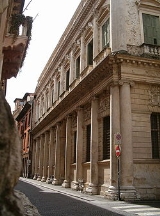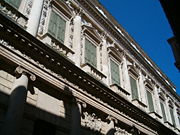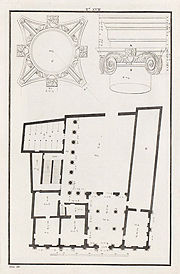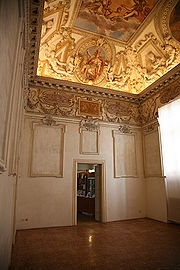
Palazzo Barbaran da Porto
Encyclopedia
Palazzo Barbaran Da Porto is a palazzo
in Vicenza
, Italy
designed in 1569 and built between 1570 and 1575 by Andrea Palladio
.
Since 1994 the palace is part of the "City of Vicenza and the Palladian Villas of the Veneto
" World Heritage Site
by UNESCO
.
In the palace is located the Museo Palladio and the Centro Internazionale di Studi di Architettura Andrea Palladio (CISA).
 The sumptuous residence realised between 1570 and 1575 for the Vicentine noble Montano Barbarano is the only great city palace that Andrea Palladio succeeded in executing in its entirety.
The sumptuous residence realised between 1570 and 1575 for the Vicentine noble Montano Barbarano is the only great city palace that Andrea Palladio succeeded in executing in its entirety.
In his History of Vicenza of 1591, Iacopo Marzari records Montano Barbarano as a man “of belles lettres and most excellent musician”. Various flutes figure in the 1592 inventory of the palace, confirming the existence of an intensive musical activity there.
At least three different autograph projects survive, preserved in London
, which document alternative hypotheses for the building’s plan, all quite different from the actual one and testimony to a complex design process. Barbarano, in fact, requested Palladio to respect the existence of various houses belonging to the family and already existing on the area of the new palace. Moreover, once the project was finalised Barbarano acquired a further house adjoining the property, which resulted in the asymmetrical positioning of the entrance portal. In any case, the constraints imposed by the site and by a practical patron became the occasion for courageous and refined solutions: Palladio’s intervention is magisterial, elaborating upon a sophisticated project for “restructuring” which blended the diverse pre-existing structures into a unified edifice.
In 1998, after a twenty-year restoration, the Palace has been opened to the public. The exhibition activities began in march 1999.

 On the ground floor, a magnificent four-columned atrium
On the ground floor, a magnificent four-columned atrium
welds together the two pre-existing building lots. In realising the scheme, Palladio was called upon to resolve two problems: one statical, how to support the floor of the great hall on the piano nobile
; the other compositional, how to restore a symmetrical appearance to interiors compromised by the oblique course of the perimeter walls from the pre-existing houses.
Departing from the model of the wings of the Theatre of Marcellus
in Rome
, Palladio divided the interior into three aisle
s, placing centrally four Ionic
columns which allowed the reduction of the span of the central cross-vaults, set against lateral barrel vault
s. He thus achieved a very statically efficient framework capable of bearing the floor of the hall above without any difficulty.
The central columns were then tied to the perimeter walls by fragments of rectilinear entablature
, which absorb the irregularities of the atrium plan: in this way he realised a sort of system of “serlianas”, a stratagem conceptually similar to that of the Basilica loggias
. Palladio even adopted the unusual type of Ionic capital — derived from the Temple of Saturn
in the Forum Romanum — because it permitted him to mask the slight but significant rotations necessary to align the columns and engaged columns.
 To decorate the palace, in several campaigns Montano employed some of the greatest artists of his time: Giovanni Battista Zelotti
To decorate the palace, in several campaigns Montano employed some of the greatest artists of his time: Giovanni Battista Zelotti
(who had already intervened in the interiors of Palladio’s Villa Emo
at Fanzolo), Anselmo Canera and Andrea Vicentino
; the stucco
es were entrusted to Lorenzo Rubini (who contemporaneously executed the external decorations of the Loggia del Capitanio) and, after his death in 1574, to his son Agostino. The net result was a sumptuous palace capable of rivalling the residences of the Thiene, the Porto
and of the Valmarana, a palace which permitted its patron to represent himself to the city as a ranking member of the Vicentine cultural élite.
Palazzo
Palazzo, an Italian word meaning a large building , may refer to:-Buildings:*Palazzo, an Italian type of building**Palazzo style architecture, imitative of Italian palazzi...
in Vicenza
Vicenza
Vicenza , a city in north-eastern Italy, is the capital of the eponymous province in the Veneto region, at the northern base of the Monte Berico, straddling the Bacchiglione...
, Italy
Italy
Italy , officially the Italian Republic languages]] under the European Charter for Regional or Minority Languages. In each of these, Italy's official name is as follows:;;;;;;;;), is a unitary parliamentary republic in South-Central Europe. To the north it borders France, Switzerland, Austria and...
designed in 1569 and built between 1570 and 1575 by Andrea Palladio
Andrea Palladio
Andrea Palladio was an architect active in the Republic of Venice. Palladio, influenced by Roman and Greek architecture, primarily by Vitruvius, is widely considered the most influential individual in the history of Western architecture...
.
Since 1994 the palace is part of the "City of Vicenza and the Palladian Villas of the Veneto
Palladian Villas of the Veneto
The City of Vicenza and the Palladian Villas of the Veneto is a World Heritage Site protecting a cluster of works by the architect Andrea Palladio. UNESCO inscribed the site on the World Heritage List in 1994. At first the site was called "Vicenza, City of Palladio" and only buildings in the...
" World Heritage Site
World Heritage Site
A UNESCO World Heritage Site is a place that is listed by the UNESCO as of special cultural or physical significance...
by UNESCO
UNESCO
The United Nations Educational, Scientific and Cultural Organization is a specialized agency of the United Nations...
.
In the palace is located the Museo Palladio and the Centro Internazionale di Studi di Architettura Andrea Palladio (CISA).
History

In his History of Vicenza of 1591, Iacopo Marzari records Montano Barbarano as a man “of belles lettres and most excellent musician”. Various flutes figure in the 1592 inventory of the palace, confirming the existence of an intensive musical activity there.
At least three different autograph projects survive, preserved in London
London
London is the capital city of :England and the :United Kingdom, the largest metropolitan area in the United Kingdom, and the largest urban zone in the European Union by most measures. Located on the River Thames, London has been a major settlement for two millennia, its history going back to its...
, which document alternative hypotheses for the building’s plan, all quite different from the actual one and testimony to a complex design process. Barbarano, in fact, requested Palladio to respect the existence of various houses belonging to the family and already existing on the area of the new palace. Moreover, once the project was finalised Barbarano acquired a further house adjoining the property, which resulted in the asymmetrical positioning of the entrance portal. In any case, the constraints imposed by the site and by a practical patron became the occasion for courageous and refined solutions: Palladio’s intervention is magisterial, elaborating upon a sophisticated project for “restructuring” which blended the diverse pre-existing structures into a unified edifice.
In 1998, after a twenty-year restoration, the Palace has been opened to the public. The exhibition activities began in march 1999.
Description


Atrium (architecture)
In modern architecture, an atrium is a large open space, often several stories high and having a glazed roof and/or large windows, often situated within a larger multistory building and often located immediately beyond the main entrance doors...
welds together the two pre-existing building lots. In realising the scheme, Palladio was called upon to resolve two problems: one statical, how to support the floor of the great hall on the piano nobile
Piano nobile
The piano nobile is the principal floor of a large house, usually built in one of the styles of classical renaissance architecture...
; the other compositional, how to restore a symmetrical appearance to interiors compromised by the oblique course of the perimeter walls from the pre-existing houses.
Departing from the model of the wings of the Theatre of Marcellus
Theatre of Marcellus
The Theatre of Marcellus is an ancient open-air theatre in Rome, Italy, built in the closing years of the Roman Republic. At the theatre, locals and visitors alike were able to watch performances of drama and song. Today its ancient edifice in the rione of Sant'Angelo, Rome, once again provides...
in Rome
Rome
Rome is the capital of Italy and the country's largest and most populated city and comune, with over 2.7 million residents in . The city is located in the central-western portion of the Italian Peninsula, on the Tiber River within the Lazio region of Italy.Rome's history spans two and a half...
, Palladio divided the interior into three aisle
Aisle
An aisle is, in general, a space for walking with rows of seats on both sides or with rows of seats on one side and a wall on the other...
s, placing centrally four Ionic
Ionic order
The Ionic order forms one of the three orders or organizational systems of classical architecture, the other two canonic orders being the Doric and the Corinthian...
columns which allowed the reduction of the span of the central cross-vaults, set against lateral barrel vault
Barrel vault
A barrel vault, also known as a tunnel vault or a wagon vault, is an architectural element formed by the extrusion of a single curve along a given distance. The curves are typically circular in shape, lending a semi-cylindrical appearance to the total design...
s. He thus achieved a very statically efficient framework capable of bearing the floor of the hall above without any difficulty.
The central columns were then tied to the perimeter walls by fragments of rectilinear entablature
Entablature
An entablature refers to the superstructure of moldings and bands which lie horizontally above columns, resting on their capitals. Entablatures are major elements of classical architecture, and are commonly divided into the architrave , the frieze ,...
, which absorb the irregularities of the atrium plan: in this way he realised a sort of system of “serlianas”, a stratagem conceptually similar to that of the Basilica loggias
Basilica Palladiana
The Basilica Palladiana is a Renaissance building in the central Piazza dei Signori in Vicenza, north-eastern Italy. The most notable feature of the edifice is the loggia, which shows one of the first examples of the what came to be known as the Palladian window, designed by a young Andrea...
. Palladio even adopted the unusual type of Ionic capital — derived from the Temple of Saturn
Temple of Saturn
The Temple of Saturn is a monument to the agricultural deity. The Temple of Saturn stands at the foot of the Capitoline Hill in the western end of the Forum Romanum in Rome, Italy.-Archaeology:...
in the Forum Romanum — because it permitted him to mask the slight but significant rotations necessary to align the columns and engaged columns.
Decoration

Giovanni Battista Zelotti
Giovanni Battista Zelotti was an Italian painter of the late Renaissance, active in Venice and her mainland territories.He appears to have been born in Venice, and trained with Antonio Badile and Domenico Riccio, as well as perhaps Titian. Bernasconi claims he trained with his uncle Paolo Farinati...
(who had already intervened in the interiors of Palladio’s Villa Emo
Villa Emo
Villa Emo is a patrician villa in the Veneto, northern Italy, near the village of Fanzolo di Vedelago. It was designed by Andrea Palladio in 1559 for the Emo family of Venice and remained in the hands of the Emo family until it was sold in 2004...
at Fanzolo), Anselmo Canera and Andrea Vicentino
Andrea Vicentino
Andrea Vicentino was an Italian painter of the late-Renaissance or Mannerist period. He was a pupil of the painter Giovanni Battista Maganza. Born in Vicenza, he was also known as Andrea Michieli or Michelli. He moved to Venice in the mid-1570s and registered in the “Fraglia” or guild of Venetian...
; the stucco
Stucco
Stucco or render is a material made of an aggregate, a binder, and water. Stucco is applied wet and hardens to a very dense solid. It is used as decorative coating for walls and ceilings and as a sculptural and artistic material in architecture...
es were entrusted to Lorenzo Rubini (who contemporaneously executed the external decorations of the Loggia del Capitanio) and, after his death in 1574, to his son Agostino. The net result was a sumptuous palace capable of rivalling the residences of the Thiene, the Porto
Porto family
The Porto surname history has its origins in the Piemonte region of what is today Italy and parts of present day Southern France. They were part of a religious sect called the Valdese; they called themselves the Poor men of Lyon, the Poor of Lombardy, or the Poor...
and of the Valmarana, a palace which permitted its patron to represent himself to the city as a ranking member of the Vicentine cultural élite.
Sources
- Palazzo Barbaran da Porto in the CISA website (source for the first revision of this article, with kind permission)

